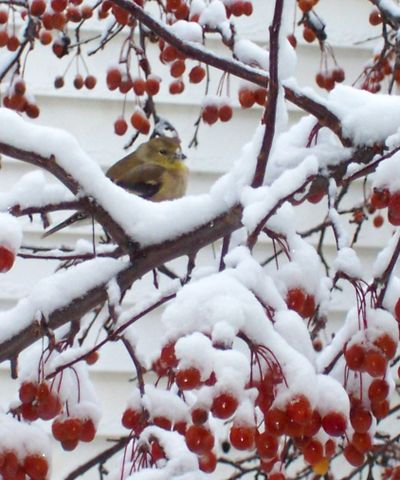Helping wild birds through winter

You’ve got to admit that wild birds are tough little customers. While we humans are languishing under our electric blankets or hovering around the woodstove with a cup of hot cocoa, they are out in the cold going about their daily routines.
This time of year, frequent visitors to our yards can include chickadees, grosbeaks, American goldfinches, California quail, juncoes, house finches, northern flickers, waxwings and nuthatches.
There are many things we can do to make it a little easier for birds to survive our cold winters, in addition to making them feel welcome in our yards. Just like the rest of us, their basic needs revolve around food, water, housing and shelter from predators.
Food
With the arrival of snow and cold temperatures, wild birds have a difficult time locating food. We can help by setting up bird-feeding stations with foods that appeal to a variety of bird species.
Seeds are the most commonly available form of wild bird food. According to the Washington Department of Fish and Wildlife’s Web site, seeds “are rich in carbohydrates and calories and supply valuable energy during cold weather.”
The best two types of seeds you can provide are black oil sunflower seeds – which appeal to a wide variety of birds – and niger thistle, which American goldfinches and pine siskens prefer.
Suet – a food source that can contain nuts, seeds, peanut butter and dried fruits – is inexpensive, with suet cakes costing under $2. It will attract birds including northern flickers, chickadees and nuthatches.
Never set out bread or crackers as that will attract starlings and sparrows, considered to be undesirable species due to their predatory and aggressive nature, as well as rodents.
It is important to keep bird feeders clean throughout the year. Last year, it was reported that birds were becoming infected with salmonella bacteria, which can be spread through their droppings.
At that time, the Department of Fish and Wildlife advised homeowners to either discontinue putting out bird feeders or clean the feeders on a daily basis with a weak bleach solution (one part bleach to 10 parts water). They also suggested using tube feeders instead of platform feeders to keep the feed clean.
If you’re a gardener who didn’t get around to cleaning up the flower beds this fall, you’ve actually done the birds a favor. Many seed-eating birds love to nibble on the seeds contained in coneflower and globe thistle heads throughout the winter.
Birds also enjoy feasting on crabapples and the berries on plants like the snowberry and American cranberry bush.
Water
Birds need water on a regular basis. If homeowners with ponds keep their waterfalls running through the winter, birds will be drawn to them.
Other options include purchasing a heated birdbath or regularly refilling an outdoor birdbath. Be sure to keep them clean.
Housing and shelter
During the winter months, birds need a place to sleep at night and to stay out of extreme weather. Shelter might be in the form of birdhouses, dense shrubs or trees.
If you’re looking for a project that will stave off cabin fever this winter, making birdhouses is a constructive, fun activity.
Building birdhouses for particular species means you need to know the correct sizes and styles, as well as the appropriately sized entrance holes. An excellent source for this information is the article on nest boxes on the Spokane Audubon Society’s Web site (spokaneaudubon.org).
In addition to housing needs, birds especially need places to hide from predators like cats or hawks. While most cats are kept indoors this time of year, hawks are naturally drawn to areas where flocks of birds are feeding.
It can be distressing when a hawk zips through your yard and snatches a wild bird feeding there, but it’s important to remember that birds of prey – also known as raptors – are an integral part of the balance that occurs in nature.
Take time to learn about the raptors you might see in your neighborhood – sharp-shinned hawks, Cooper’s hawks and goshawks are especially prevalent right now – and count yourself lucky if you have the opportunity to identify and observe them.
Merlins, which are also known as pigeon hawks, are small falcons the size of a pigeon that are often seen in town, perching on church steeples or tree tops.
When landscaping your yard with birds in mind, plant shrubs near your bird feeders and bird baths. In addition to providing birds a place to hide should a hawk fly into the yard, the shrubbery will make the birds feel more secure about visiting your feeders.
However, don’t plant the shrubs so closely that cats could easily sneak up on feeding or bathing birds.